Financial Accounting Report: Investment Property Compliance and Impact
VerifiedAdded on 2022/12/27
|8
|2011
|1
Report
AI Summary
This report provides an executive summary and detailed analysis of financial accounting practices concerning investment property, particularly within the Australian retail industry. It focuses on the application of AASB 140 (Investment Property) and its impact on companies like Shopping Centres Australia Property Group (SCP). The report explores the accounting policies, regulations, and the effects of economic changes on the retail sector. It examines the definitions of investment property, the choice between cost and fair value models, and the recognition of assets. The analysis includes the impact of AASB 140 on financial statements, asset valuation, and the implications for investment decisions. The report also addresses the amendments to IAS 40, the decline in the retail industry, and the potential changes in SCP's financial reporting, including the recognition of rental income, operating expenses, and fair value changes. References to relevant academic articles are also provided.
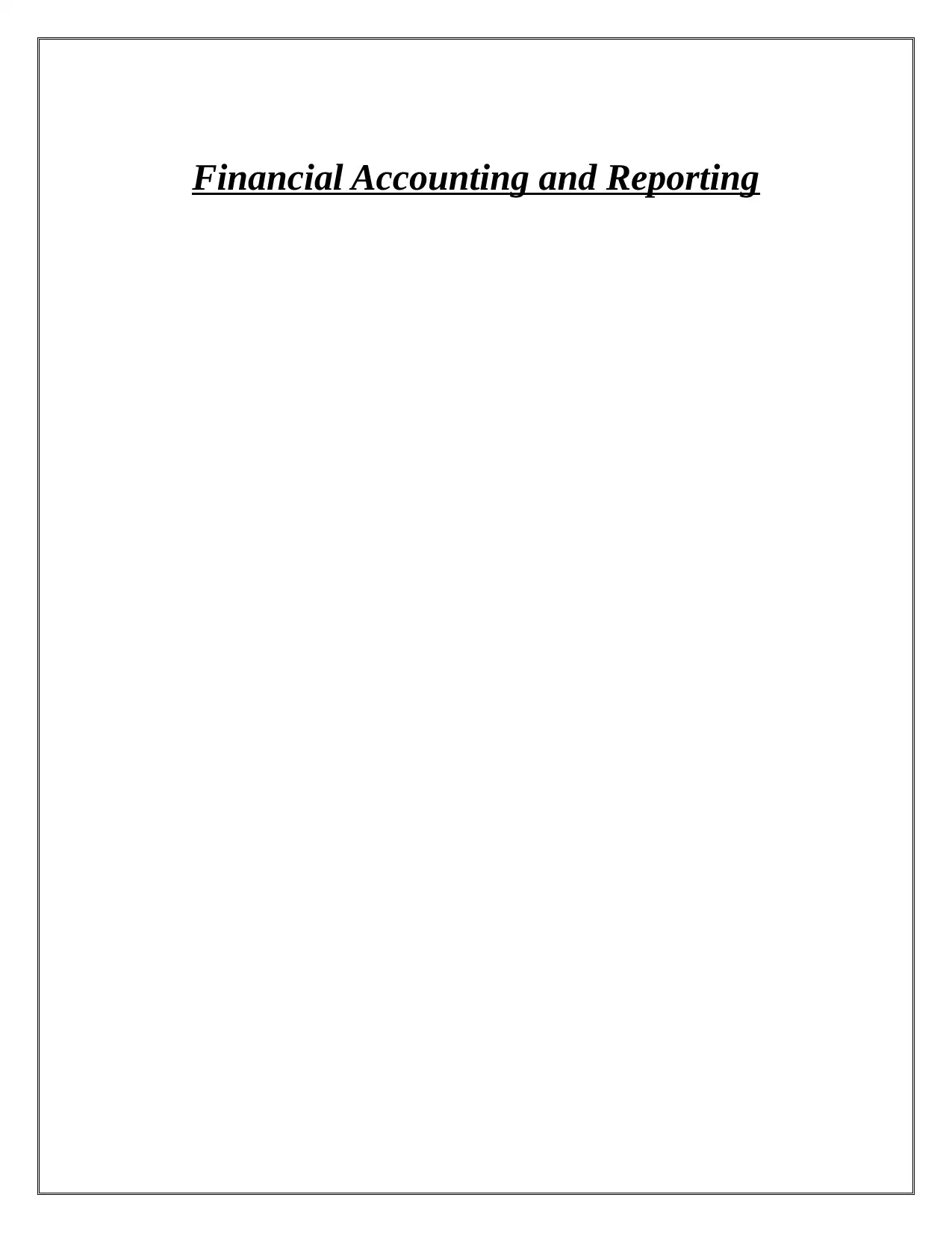
Financial Accounting and Reporting
Paraphrase This Document
Need a fresh take? Get an instant paraphrase of this document with our AI Paraphraser
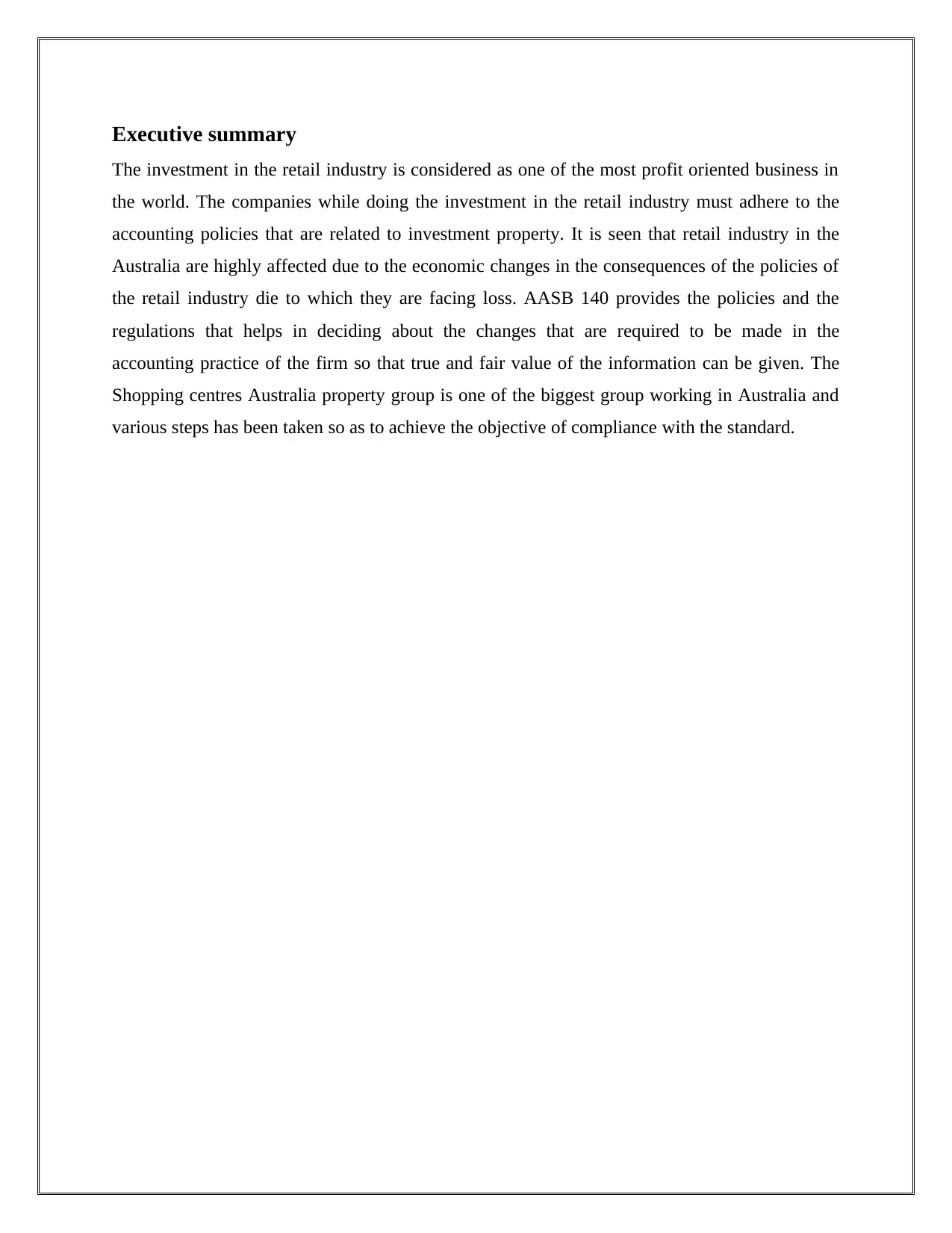
Executive summary
The investment in the retail industry is considered as one of the most profit oriented business in
the world. The companies while doing the investment in the retail industry must adhere to the
accounting policies that are related to investment property. It is seen that retail industry in the
Australia are highly affected due to the economic changes in the consequences of the policies of
the retail industry die to which they are facing loss. AASB 140 provides the policies and the
regulations that helps in deciding about the changes that are required to be made in the
accounting practice of the firm so that true and fair value of the information can be given. The
Shopping centres Australia property group is one of the biggest group working in Australia and
various steps has been taken so as to achieve the objective of compliance with the standard.
The investment in the retail industry is considered as one of the most profit oriented business in
the world. The companies while doing the investment in the retail industry must adhere to the
accounting policies that are related to investment property. It is seen that retail industry in the
Australia are highly affected due to the economic changes in the consequences of the policies of
the retail industry die to which they are facing loss. AASB 140 provides the policies and the
regulations that helps in deciding about the changes that are required to be made in the
accounting practice of the firm so that true and fair value of the information can be given. The
Shopping centres Australia property group is one of the biggest group working in Australia and
various steps has been taken so as to achieve the objective of compliance with the standard.
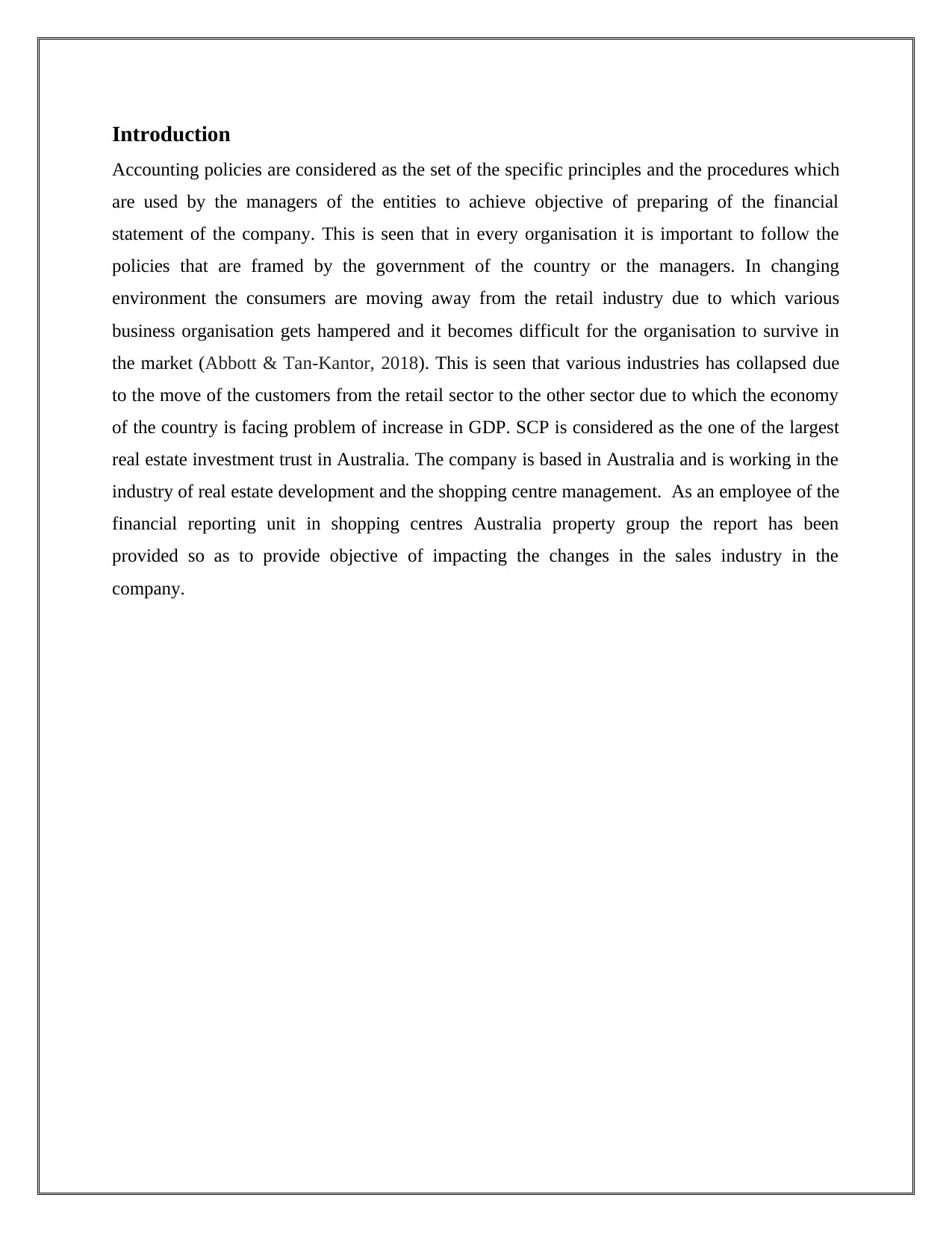
Introduction
Accounting policies are considered as the set of the specific principles and the procedures which
are used by the managers of the entities to achieve objective of preparing of the financial
statement of the company. This is seen that in every organisation it is important to follow the
policies that are framed by the government of the country or the managers. In changing
environment the consumers are moving away from the retail industry due to which various
business organisation gets hampered and it becomes difficult for the organisation to survive in
the market (Abbott & Tan‐Kantor, 2018). This is seen that various industries has collapsed due
to the move of the customers from the retail sector to the other sector due to which the economy
of the country is facing problem of increase in GDP. SCP is considered as the one of the largest
real estate investment trust in Australia. The company is based in Australia and is working in the
industry of real estate development and the shopping centre management. As an employee of the
financial reporting unit in shopping centres Australia property group the report has been
provided so as to provide objective of impacting the changes in the sales industry in the
company.
Accounting policies are considered as the set of the specific principles and the procedures which
are used by the managers of the entities to achieve objective of preparing of the financial
statement of the company. This is seen that in every organisation it is important to follow the
policies that are framed by the government of the country or the managers. In changing
environment the consumers are moving away from the retail industry due to which various
business organisation gets hampered and it becomes difficult for the organisation to survive in
the market (Abbott & Tan‐Kantor, 2018). This is seen that various industries has collapsed due
to the move of the customers from the retail sector to the other sector due to which the economy
of the country is facing problem of increase in GDP. SCP is considered as the one of the largest
real estate investment trust in Australia. The company is based in Australia and is working in the
industry of real estate development and the shopping centre management. As an employee of the
financial reporting unit in shopping centres Australia property group the report has been
provided so as to provide objective of impacting the changes in the sales industry in the
company.
⊘ This is a preview!⊘
Do you want full access?
Subscribe today to unlock all pages.

Trusted by 1+ million students worldwide
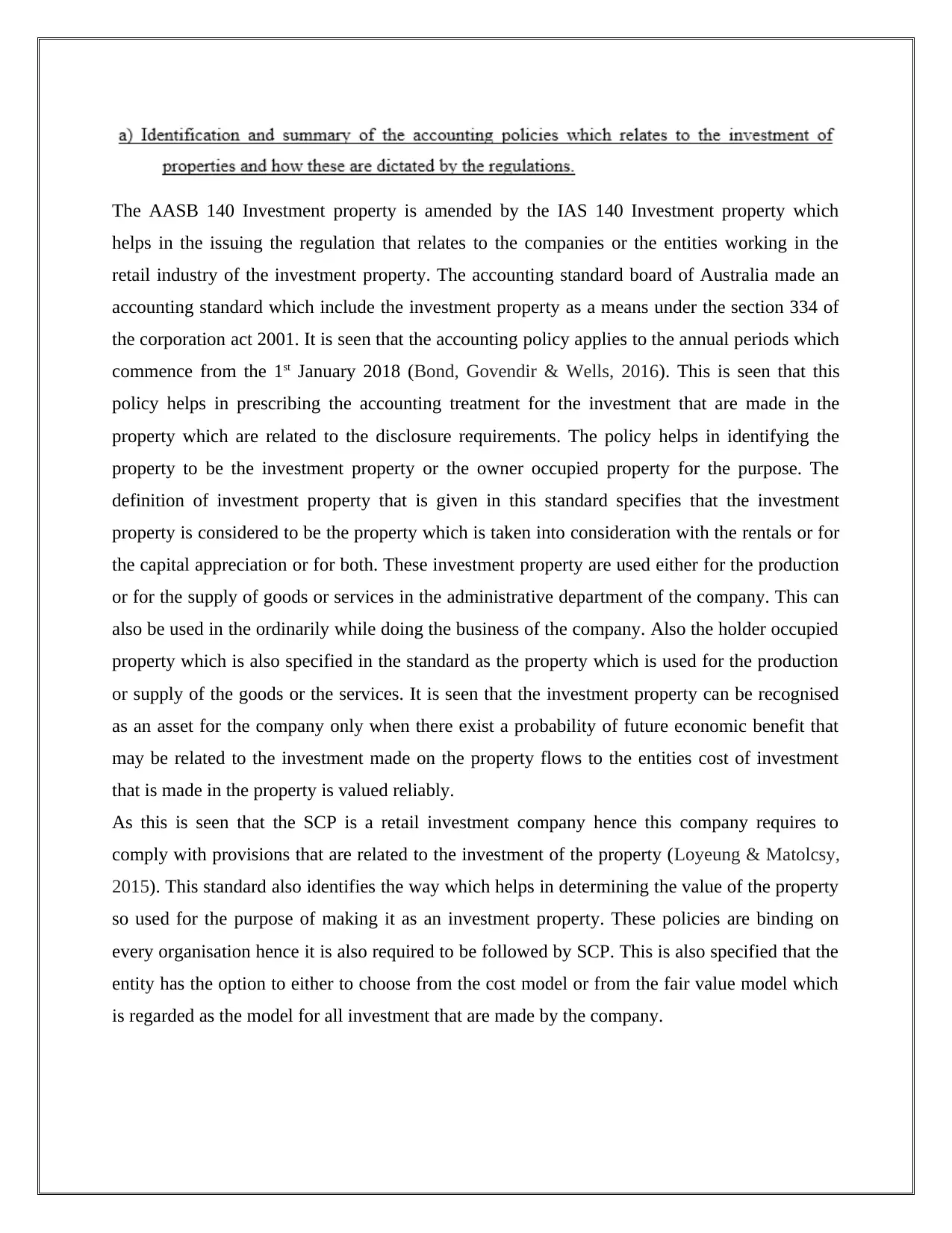
The AASB 140 Investment property is amended by the IAS 140 Investment property which
helps in the issuing the regulation that relates to the companies or the entities working in the
retail industry of the investment property. The accounting standard board of Australia made an
accounting standard which include the investment property as a means under the section 334 of
the corporation act 2001. It is seen that the accounting policy applies to the annual periods which
commence from the 1st January 2018 (Bond, Govendir & Wells, 2016). This is seen that this
policy helps in prescribing the accounting treatment for the investment that are made in the
property which are related to the disclosure requirements. The policy helps in identifying the
property to be the investment property or the owner occupied property for the purpose. The
definition of investment property that is given in this standard specifies that the investment
property is considered to be the property which is taken into consideration with the rentals or for
the capital appreciation or for both. These investment property are used either for the production
or for the supply of goods or services in the administrative department of the company. This can
also be used in the ordinarily while doing the business of the company. Also the holder occupied
property which is also specified in the standard as the property which is used for the production
or supply of the goods or the services. It is seen that the investment property can be recognised
as an asset for the company only when there exist a probability of future economic benefit that
may be related to the investment made on the property flows to the entities cost of investment
that is made in the property is valued reliably.
As this is seen that the SCP is a retail investment company hence this company requires to
comply with provisions that are related to the investment of the property (Loyeung & Matolcsy,
2015). This standard also identifies the way which helps in determining the value of the property
so used for the purpose of making it as an investment property. These policies are binding on
every organisation hence it is also required to be followed by SCP. This is also specified that the
entity has the option to either to choose from the cost model or from the fair value model which
is regarded as the model for all investment that are made by the company.
helps in the issuing the regulation that relates to the companies or the entities working in the
retail industry of the investment property. The accounting standard board of Australia made an
accounting standard which include the investment property as a means under the section 334 of
the corporation act 2001. It is seen that the accounting policy applies to the annual periods which
commence from the 1st January 2018 (Bond, Govendir & Wells, 2016). This is seen that this
policy helps in prescribing the accounting treatment for the investment that are made in the
property which are related to the disclosure requirements. The policy helps in identifying the
property to be the investment property or the owner occupied property for the purpose. The
definition of investment property that is given in this standard specifies that the investment
property is considered to be the property which is taken into consideration with the rentals or for
the capital appreciation or for both. These investment property are used either for the production
or for the supply of goods or services in the administrative department of the company. This can
also be used in the ordinarily while doing the business of the company. Also the holder occupied
property which is also specified in the standard as the property which is used for the production
or supply of the goods or the services. It is seen that the investment property can be recognised
as an asset for the company only when there exist a probability of future economic benefit that
may be related to the investment made on the property flows to the entities cost of investment
that is made in the property is valued reliably.
As this is seen that the SCP is a retail investment company hence this company requires to
comply with provisions that are related to the investment of the property (Loyeung & Matolcsy,
2015). This standard also identifies the way which helps in determining the value of the property
so used for the purpose of making it as an investment property. These policies are binding on
every organisation hence it is also required to be followed by SCP. This is also specified that the
entity has the option to either to choose from the cost model or from the fair value model which
is regarded as the model for all investment that are made by the company.
Paraphrase This Document
Need a fresh take? Get an instant paraphrase of this document with our AI Paraphraser
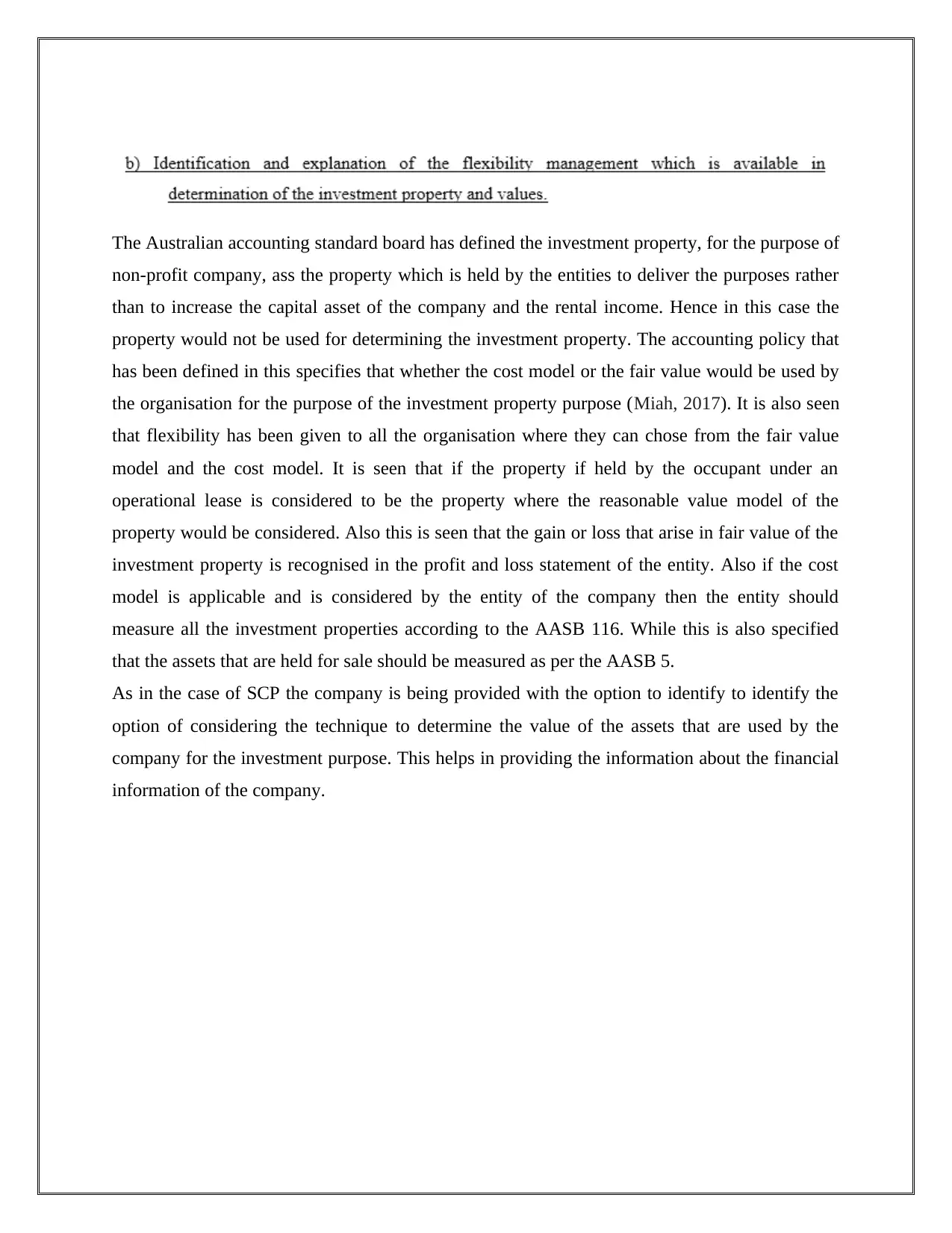
The Australian accounting standard board has defined the investment property, for the purpose of
non-profit company, ass the property which is held by the entities to deliver the purposes rather
than to increase the capital asset of the company and the rental income. Hence in this case the
property would not be used for determining the investment property. The accounting policy that
has been defined in this specifies that whether the cost model or the fair value would be used by
the organisation for the purpose of the investment property purpose (Miah, 2017). It is also seen
that flexibility has been given to all the organisation where they can chose from the fair value
model and the cost model. It is seen that if the property if held by the occupant under an
operational lease is considered to be the property where the reasonable value model of the
property would be considered. Also this is seen that the gain or loss that arise in fair value of the
investment property is recognised in the profit and loss statement of the entity. Also if the cost
model is applicable and is considered by the entity of the company then the entity should
measure all the investment properties according to the AASB 116. While this is also specified
that the assets that are held for sale should be measured as per the AASB 5.
As in the case of SCP the company is being provided with the option to identify to identify the
option of considering the technique to determine the value of the assets that are used by the
company for the investment purpose. This helps in providing the information about the financial
information of the company.
non-profit company, ass the property which is held by the entities to deliver the purposes rather
than to increase the capital asset of the company and the rental income. Hence in this case the
property would not be used for determining the investment property. The accounting policy that
has been defined in this specifies that whether the cost model or the fair value would be used by
the organisation for the purpose of the investment property purpose (Miah, 2017). It is also seen
that flexibility has been given to all the organisation where they can chose from the fair value
model and the cost model. It is seen that if the property if held by the occupant under an
operational lease is considered to be the property where the reasonable value model of the
property would be considered. Also this is seen that the gain or loss that arise in fair value of the
investment property is recognised in the profit and loss statement of the entity. Also if the cost
model is applicable and is considered by the entity of the company then the entity should
measure all the investment properties according to the AASB 116. While this is also specified
that the assets that are held for sale should be measured as per the AASB 5.
As in the case of SCP the company is being provided with the option to identify to identify the
option of considering the technique to determine the value of the assets that are used by the
company for the investment purpose. This helps in providing the information about the financial
information of the company.
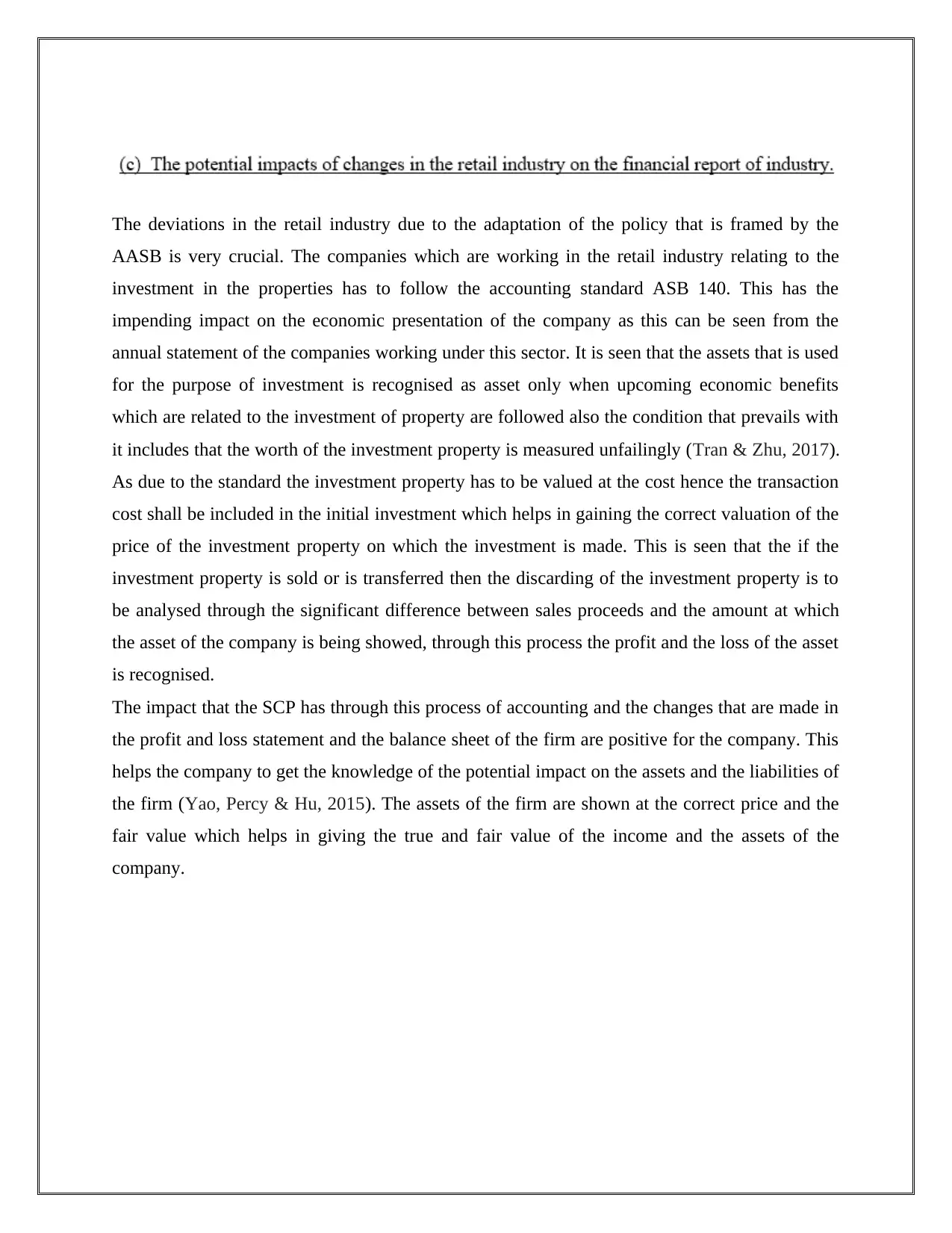
The deviations in the retail industry due to the adaptation of the policy that is framed by the
AASB is very crucial. The companies which are working in the retail industry relating to the
investment in the properties has to follow the accounting standard ASB 140. This has the
impending impact on the economic presentation of the company as this can be seen from the
annual statement of the companies working under this sector. It is seen that the assets that is used
for the purpose of investment is recognised as asset only when upcoming economic benefits
which are related to the investment of property are followed also the condition that prevails with
it includes that the worth of the investment property is measured unfailingly (Tran & Zhu, 2017).
As due to the standard the investment property has to be valued at the cost hence the transaction
cost shall be included in the initial investment which helps in gaining the correct valuation of the
price of the investment property on which the investment is made. This is seen that the if the
investment property is sold or is transferred then the discarding of the investment property is to
be analysed through the significant difference between sales proceeds and the amount at which
the asset of the company is being showed, through this process the profit and the loss of the asset
is recognised.
The impact that the SCP has through this process of accounting and the changes that are made in
the profit and loss statement and the balance sheet of the firm are positive for the company. This
helps the company to get the knowledge of the potential impact on the assets and the liabilities of
the firm (Yao, Percy & Hu, 2015). The assets of the firm are shown at the correct price and the
fair value which helps in giving the true and fair value of the income and the assets of the
company.
AASB is very crucial. The companies which are working in the retail industry relating to the
investment in the properties has to follow the accounting standard ASB 140. This has the
impending impact on the economic presentation of the company as this can be seen from the
annual statement of the companies working under this sector. It is seen that the assets that is used
for the purpose of investment is recognised as asset only when upcoming economic benefits
which are related to the investment of property are followed also the condition that prevails with
it includes that the worth of the investment property is measured unfailingly (Tran & Zhu, 2017).
As due to the standard the investment property has to be valued at the cost hence the transaction
cost shall be included in the initial investment which helps in gaining the correct valuation of the
price of the investment property on which the investment is made. This is seen that the if the
investment property is sold or is transferred then the discarding of the investment property is to
be analysed through the significant difference between sales proceeds and the amount at which
the asset of the company is being showed, through this process the profit and the loss of the asset
is recognised.
The impact that the SCP has through this process of accounting and the changes that are made in
the profit and loss statement and the balance sheet of the firm are positive for the company. This
helps the company to get the knowledge of the potential impact on the assets and the liabilities of
the firm (Yao, Percy & Hu, 2015). The assets of the firm are shown at the correct price and the
fair value which helps in giving the true and fair value of the income and the assets of the
company.
⊘ This is a preview!⊘
Do you want full access?
Subscribe today to unlock all pages.

Trusted by 1+ million students worldwide
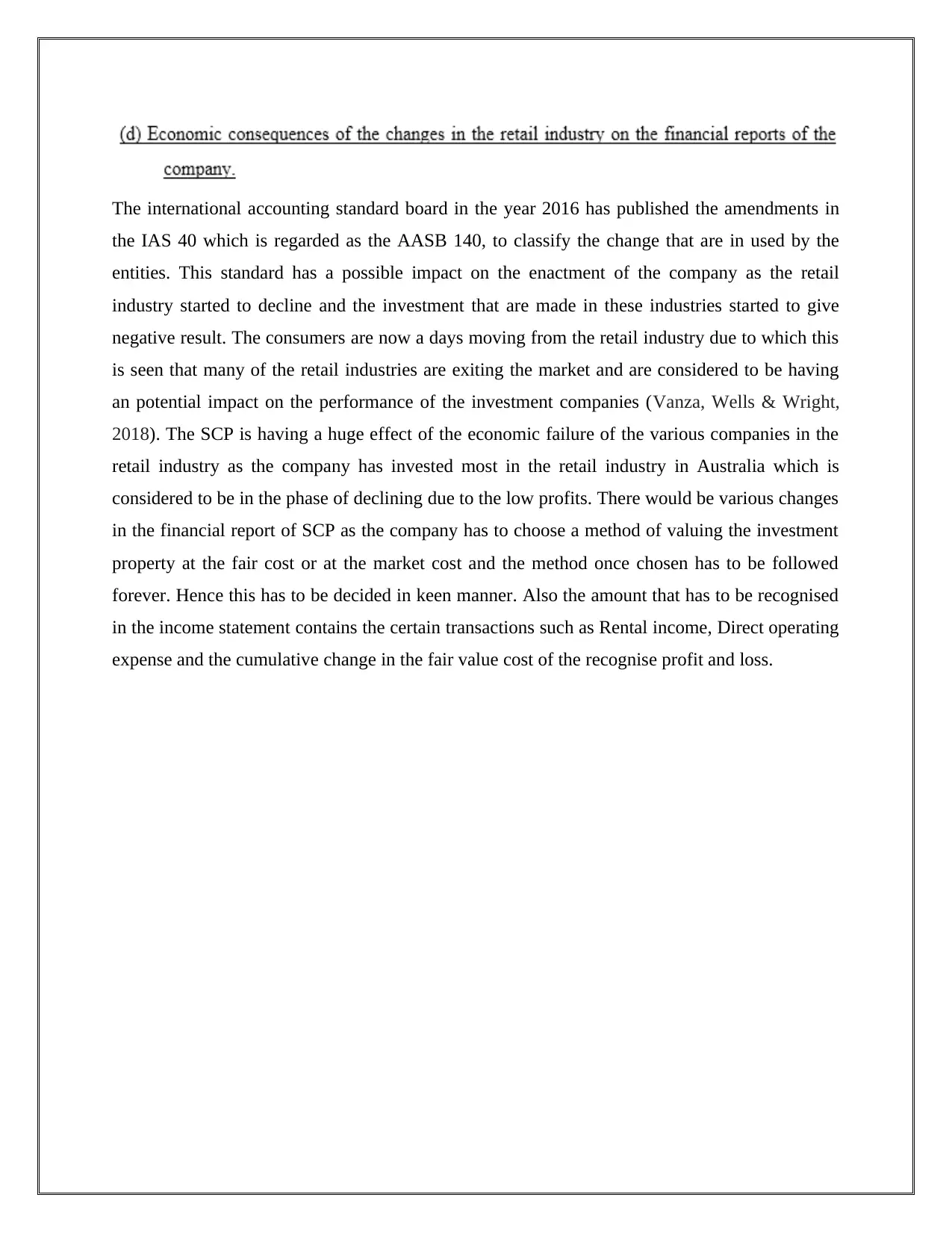
The international accounting standard board in the year 2016 has published the amendments in
the IAS 40 which is regarded as the AASB 140, to classify the change that are in used by the
entities. This standard has a possible impact on the enactment of the company as the retail
industry started to decline and the investment that are made in these industries started to give
negative result. The consumers are now a days moving from the retail industry due to which this
is seen that many of the retail industries are exiting the market and are considered to be having
an potential impact on the performance of the investment companies (Vanza, Wells & Wright,
2018). The SCP is having a huge effect of the economic failure of the various companies in the
retail industry as the company has invested most in the retail industry in Australia which is
considered to be in the phase of declining due to the low profits. There would be various changes
in the financial report of SCP as the company has to choose a method of valuing the investment
property at the fair cost or at the market cost and the method once chosen has to be followed
forever. Hence this has to be decided in keen manner. Also the amount that has to be recognised
in the income statement contains the certain transactions such as Rental income, Direct operating
expense and the cumulative change in the fair value cost of the recognise profit and loss.
the IAS 40 which is regarded as the AASB 140, to classify the change that are in used by the
entities. This standard has a possible impact on the enactment of the company as the retail
industry started to decline and the investment that are made in these industries started to give
negative result. The consumers are now a days moving from the retail industry due to which this
is seen that many of the retail industries are exiting the market and are considered to be having
an potential impact on the performance of the investment companies (Vanza, Wells & Wright,
2018). The SCP is having a huge effect of the economic failure of the various companies in the
retail industry as the company has invested most in the retail industry in Australia which is
considered to be in the phase of declining due to the low profits. There would be various changes
in the financial report of SCP as the company has to choose a method of valuing the investment
property at the fair cost or at the market cost and the method once chosen has to be followed
forever. Hence this has to be decided in keen manner. Also the amount that has to be recognised
in the income statement contains the certain transactions such as Rental income, Direct operating
expense and the cumulative change in the fair value cost of the recognise profit and loss.
Paraphrase This Document
Need a fresh take? Get an instant paraphrase of this document with our AI Paraphraser
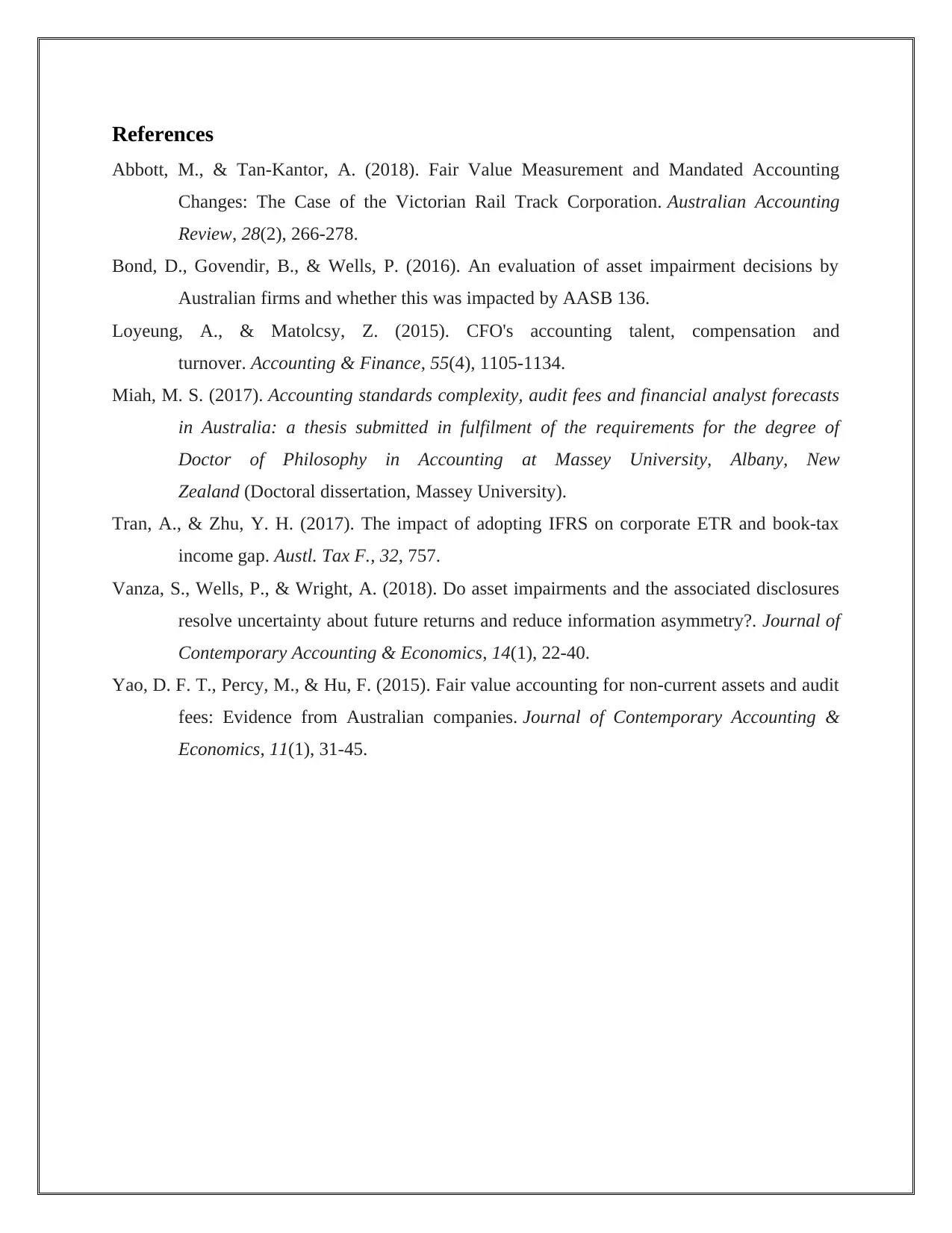
References
Abbott, M., & Tan‐Kantor, A. (2018). Fair Value Measurement and Mandated Accounting
Changes: The Case of the Victorian Rail Track Corporation. Australian Accounting
Review, 28(2), 266-278.
Bond, D., Govendir, B., & Wells, P. (2016). An evaluation of asset impairment decisions by
Australian firms and whether this was impacted by AASB 136.
Loyeung, A., & Matolcsy, Z. (2015). CFO's accounting talent, compensation and
turnover. Accounting & Finance, 55(4), 1105-1134.
Miah, M. S. (2017). Accounting standards complexity, audit fees and financial analyst forecasts
in Australia: a thesis submitted in fulfilment of the requirements for the degree of
Doctor of Philosophy in Accounting at Massey University, Albany, New
Zealand (Doctoral dissertation, Massey University).
Tran, A., & Zhu, Y. H. (2017). The impact of adopting IFRS on corporate ETR and book-tax
income gap. Austl. Tax F., 32, 757.
Vanza, S., Wells, P., & Wright, A. (2018). Do asset impairments and the associated disclosures
resolve uncertainty about future returns and reduce information asymmetry?. Journal of
Contemporary Accounting & Economics, 14(1), 22-40.
Yao, D. F. T., Percy, M., & Hu, F. (2015). Fair value accounting for non-current assets and audit
fees: Evidence from Australian companies. Journal of Contemporary Accounting &
Economics, 11(1), 31-45.
Abbott, M., & Tan‐Kantor, A. (2018). Fair Value Measurement and Mandated Accounting
Changes: The Case of the Victorian Rail Track Corporation. Australian Accounting
Review, 28(2), 266-278.
Bond, D., Govendir, B., & Wells, P. (2016). An evaluation of asset impairment decisions by
Australian firms and whether this was impacted by AASB 136.
Loyeung, A., & Matolcsy, Z. (2015). CFO's accounting talent, compensation and
turnover. Accounting & Finance, 55(4), 1105-1134.
Miah, M. S. (2017). Accounting standards complexity, audit fees and financial analyst forecasts
in Australia: a thesis submitted in fulfilment of the requirements for the degree of
Doctor of Philosophy in Accounting at Massey University, Albany, New
Zealand (Doctoral dissertation, Massey University).
Tran, A., & Zhu, Y. H. (2017). The impact of adopting IFRS on corporate ETR and book-tax
income gap. Austl. Tax F., 32, 757.
Vanza, S., Wells, P., & Wright, A. (2018). Do asset impairments and the associated disclosures
resolve uncertainty about future returns and reduce information asymmetry?. Journal of
Contemporary Accounting & Economics, 14(1), 22-40.
Yao, D. F. T., Percy, M., & Hu, F. (2015). Fair value accounting for non-current assets and audit
fees: Evidence from Australian companies. Journal of Contemporary Accounting &
Economics, 11(1), 31-45.
1 out of 8
Related Documents
Your All-in-One AI-Powered Toolkit for Academic Success.
+13062052269
info@desklib.com
Available 24*7 on WhatsApp / Email
![[object Object]](/_next/static/media/star-bottom.7253800d.svg)
Unlock your academic potential
Copyright © 2020–2025 A2Z Services. All Rights Reserved. Developed and managed by ZUCOL.





